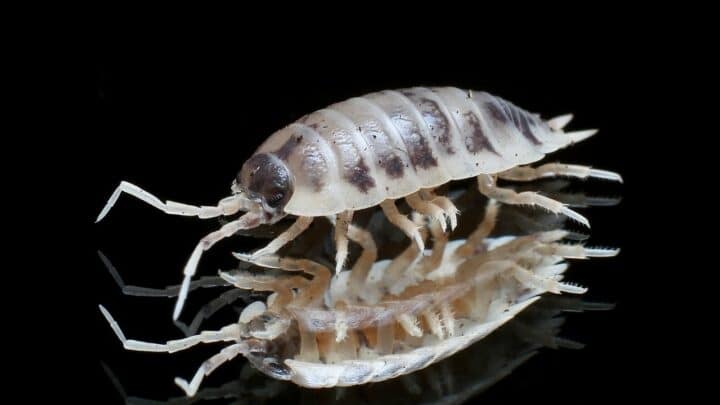Isopods are tiny crustaceans universally famous for their clean-up abilities. And let’s face it, that’s not a bad reputation to have in the ecological sphere.
Indeed, it is this inherent talent that has made them a popular choice of critter in vivariums the world over. They’re hardy, easy to breed, and beneficial to have around.
Now, if you’re interested in creating a vivarium, there are 10 isopods that are best to place in such a home!
If, like me, you’ve ever found yourself wondering how long isopods live, read on to find out more.
How long do isopods live?
Isopods, also known as sowbugs or pillbugs, live for an average age of 2 years, although some studies show that, in ideal conditions, they can live for up to five years. While they generally reach adulthood within 12 weeks of being born, baby isopods are most at risk during their first weeks of life.
Lifecycle of an Isopod
Isopods reach sexual maturity at around 12 weeks. Females can start to breed from this point onwards, with most species reproducing once or twice per year.
But, before you jumpstart with creating lots of mini isopods, learn and read all about breeding isopods so you can have a better idea of how to start and what to expect when it’s finally happening.
Female isopods produce eggs that they carry in a pouch, called a marsupium, located on their abdomens. An average isopod’s bearing consists of around 200 eggs per reproductive cycle.
A female isopod’s eggs will brood within her pouch for 3 to 7 weeks, whereafter the hatched young will live in her pouch for a further 6 to 7 weeks. After this, they leave their moms and never return.
You might be interested in learning how isopods reproduce, so do your reading on it.
At this stage, they are much smaller than adult isopods, and their outer shells have not yet fully hardened, making their delicate undercarriages vulnerable to drying out.
Regardless, they get down to business and immediately start feeding. They then shed their skin as they mature.
During their lifespans, isopods will molt up to a dozen times, shedding their exoskeletons to make way for their impending size increase. They eat their shed skin, which is nutrient-rich.
During the winter months, they are inactive, preferring to find shelter in logs or under rocks. In spring, they become active again and start their reproductive cycles once more.
After roughly two to three years, isopods that have not been harmed by predators or environmental factors usually succumb to old age.
Factors Preventing Isopods from Reaching Adulthood
While isopods can easily live for an average of two years, their chances of survival increase drastically once they’ve reached maturity. Newborn and juvenile isopods are most at risk of being killed by predators or threats in their environments.
For starters, some vivarium inhabitants that leave adult isopods alone may not be as discerning when it comes to their soft, slow, tiny babies. Hence, it’s advisable to keep breeding isopods in their own tank.
Secondly, baby isopods are at risk of crush injuries. Their hard exoskeletons have not fully developed, so something as simple as lifting a tank rock can unintentionally eviscerate a hoard of juveniles.
Thirdly, baby isopods are much more sensitive to temperature and moisture than their parents. Breeding females may not be able to reproduce if they have inadequate access to coolness, dampness, and darkness.
Finally, there needs to be enough food in their environments. Size matters when it comes to feeding in a vivarium, so the chances are that inadequate resources will lead to a devasting case of survival of the fittest.
Youngsters don’t necessarily fall into this category.
Ideal Conditions for Isopods
Isopods are detritivores, which means that they gain all their nutrients from decaying or decomposing matter.
Consequently, their ideal environments are ones in which they have access to dead or dying plant matter, animal excrement, or supplemental nutrient-rich foods like vegetables and fruits like apples.
Furthermore, because they breathe through gills, they also rely on moisture to survive.
These tiny cousins of the crab and lobster need to keep their gills damp at all times, so you’ll generally find them in dark, humid spaces where natural moisture occurs.
Hence, you don’t need to worry about why your isopods prefer to live in dark environments.
This includes under the soil’s surface, under bark or rocks, in leaf litter, or along the foundations of houses.
In vivariums, they’ll also find areas to hide underneath or burrow into and seldom make an appearance in daylight, preferring the cover of darkness.
Frequently Asked Questions about How Long Isopods Live
What is a suitable environment for isopods?
Make sure your tanks are full of hiding places. These can occur naturally in the substrate you choose, or you may want to incorporate elements into your tank, like wood or rocks, that provide such a space for them. Of course, always make sure they have sufficient food too.
What are giant isopods, and how long do they live?
Giant isopods are an excellent example of deep-sea giantism, reaching lengths of up to 19 inches (50 centimeters). They’re found in the deep, dark waters of the Pacific, Atlantic, and Indian oceans. Their exact lifespan’s unknown, but those in captivity live up to 5 years without food.
What eats isopods?
Some small mammals, spiders, beetles, and centipedes, are all known to snack on wild isopods from time to time. In captivity, they are often used as food for vivarium pets like frogs, lizards, and toads.
Conclusion
While isopods may live short lives, they are undoubtedly eventful. When these tiny creatures aren’t feeding, they’re dodging danger or in the process of reproducing.
And when it’s all over, they return to the earth as nutrients for other creatures and plants to thrive on.


